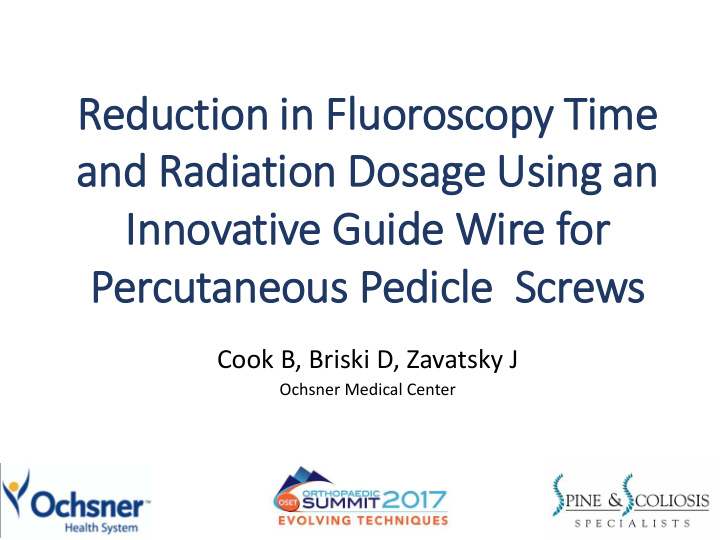



Reduction on i in F Fluor oros oscop opy T y Time e and Ra Radiati tion Do Dosa sage Using a g an Innovative G Guide W e Wire f e for Percutan aneou eous P Pedicle Screws Cook B, Briski D, Zavatsky J Ochsner Medical Center
Discl closures • Consultant – DePuy Synthes Spine, Biomet, Amendia, Innovative Surgical Solutions, Safe Wire • Royalties – Biomet
Introduction • Minimally invasive spine surgery has many potential benefits: • Shorter hospital stay • Less blood loss • Faster return to function • There are, however, inherent risks to the patient and surgeon • Numerous studies demonstrate increased radiation exposure with MIS secondary to the need for increased fluoroscopic surveillance, thereby increasing the risk of cataracts and malignancy • Inadvertent advancement of standard straight guide wires through the anterior vertebral body can also occur. • Performing bi-cortical S1 fixation • Osteoporotic bone • This advancement can injure the organs ventral to the spinal column
Introduction • Recently, a split-tip guide wire was introduced which can prevent inadvertent advancement of the wire • May decrease the need for excessive fluoroscopic guidance and radiation exposure to patient and surgeon • May decrease the risk of injury to ventral structures • Our study evaluates the benefit of utilizing a novel split-tip guide wire for percutaneous pedicle screw placement
Methods • Thirty consecutive cases of MIS transforaminal interbody fusion (TLIF) at L5-S1 were retrospectively evaluated • Group 1: Standard straight guide wire, 15 patients • Group 2: Split-tip guide wire, 15 patients • Except for the type of guide wire used, the same operative technique was used in each case • Bi-cortical S1 screw fixation was performed in each case, with tapping of anterior cortex over the guide wire before screw insertion
Imaging ng
Methods • Outcome measures: • Total fluoroscopy time • Radiation dosage • Operative time • Complications
Results ts • Total fluoroscopy time per case for Group 1 averaged 231.1 seconds vs. 154.2 seconds for Group 2 (P=0.017) • Radiation dosage for Group 1 averaged 16.22 rads vs. 8.69 rads in Group 2 (P<0.001) • There was no significant difference in operative time (P=0.18) • Inadvertent advancement of two S1 guide wires occurred in two different patients in Group 1 • Postoperative abdominal CT scans with contrast were negative in each case • There were no other complications
Conclusion • Utilizing a split-tip guide wire for percutaneous pedicle screw placement significantly decreased fluoroscopy time by 33% and radiation dosage by 46%. • The split-tip of the guide wire can prevent the wire from advancing, thereby decreasing the need for increased radiographic surveillance. • Tapping the anterior S1 cortex allows for bi-cortical screw purchase which is biomechanically stronger, but removes the mechanical stop that can prevent inadvertent guide wire advancement.
Conclusion • The split-tip guide wire may prevent inadvertent guide wire advancement and decreases the need for fluoroscopic surveillance • In two cases using the standard, straight guide wires, we had inadvertent advancement while threading the instruments over the guide wire. • To ensure the safety of the patient, each underwent an abdominal CT scan with contrast to ensure there was no bowel or vascular injury. • This advancement can injure these structures and necessitate a CT scan.
THANK Y NK YOU
Recommend
More recommend